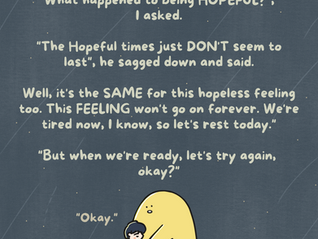WORKSHEET: Are you stuck in a Pursuer-Distancer relationship?
- Hernping
- 23 hours ago
- 2 min read
Here's some ways to break the cycle?

In my relationship, I'm the Pursuer. My wife is the Distancer / avoider. It drives me nuts sometimes.
What this means is that as the Pursuer, it often feels like I need to "chase" my wife to love me more, whether be it asking her to express herself, her emotions about the relationship, or even be willing to sit and talk about conflict.
My wife as the Distancer, just doesn't seem to get it. In fact, to her it would feel like I keep asking for too much, and that any sign of me starting a "pursuit" is a sigh of UH-OH this is happening again.
Thankfully we've gotten a lot better at communicating over time, but let's jump back to the subject.
A pursuer-distancer relationship is a common dynamic that shows up in romantic relationships, friendships, and even family connections. It describes a pattern where:
One person (the pursuer) seeks more closeness, connection, and communication—often out of a fear of disconnection or rejection.
The other person (the distancer) tends to pull away, needing more space or independence—often out of a fear of being overwhelmed or losing autonomy.
Here's how it usually plays out:
The pursuer might say things like:
“Why don’t you talk to me more?”
“We never spend time together.”
“I just want to feel close to you.”
The distancer might respond with:
“I just need some space.”
“You’re too needy.”
“You’re suffocating me.”
And then—this is key—the more the pursuer chases, the more the distancer withdraws.
The more the distancer pulls away, the more desperate the pursuer becomes. It can become a painful cycle unless both people become aware of the pattern and work to meet in the middle.
Why does this happen?
It often stems from different attachment styles:
Pursuers tend to have anxious attachment—craving connection and reassurance.
Distancers tend to have avoidant attachment—valuing independence and emotional distance.
Here's how to break the cycle.
In the worksheet attached, I've outlined some of the common traits for Pursuers and Distancers.
These traits are meant to give a bit of understanding about WHY the pursuer pursues, and why the distancer distances. For example:
The pursuer might be feeling anxious about the relationship, they crave closeness but in that moment don't feel close. They also want words of affirmation but somehow the other struggles with this at the moment. This triggers more feelings and perhaps a deep seated abandonment wound.
The distancer actually craves more of emotional stability and when emotions arise they just want to quickly "solve" it, but in solving it they miss out on what the pursuer is actually asking for. And so the conversation escalates and the Pursuer feels more and more overwhelmed, wanting space.
A relationship is always about two people in a delicate balancing of Feelings and Needs. So if this article resonates with you, have a read through the worksheet and identify the traits that apply to both of you and talk more about it.
Then go to the next section that involves some challenges for "growth". This has worked well for other couples, I hope it works well for you too.
Take care, Hernping
.jpg)















Comments